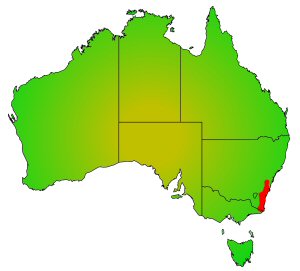Variable spiny cray facts for kids
Quick facts for kids Variable spiny cray |
|
|---|---|
| Conservation status | |
| Scientific classification | |
| Genus: |
Euastacus
|
| Species: |
yanga
|
 |
|
| Distribution map of Euastacus yanga | |
The variable spiny cray (also known as Euastacus yanga) is a type of freshwater crayfish. It lives only in southeastern Australia. These unique creatures are known for their spiny bodies.
Contents
About the Variable Spiny Cray
The biggest variable spiny cray ever found was about 61.2 mm (2.41 in) long. This measurement is called OCL, which means Occipital Carapace Length. It measures the top part of their shell.
What It Looks Like
- Head (Rostrum): The rostrum is like a short nose on its head. In bigger crayfish (over 50 mm (2.0 in) OCL), it usually doesn't reach the base of their third antenna. Smaller ones might have a longer rostrum.
- Body (Cephalon and Thorax): The head part (cephalon) is often spiny, especially on larger crayfish. The body section (thorax) can have up to 20 spines on each side. These spines are usually sharper and longer on crayfish found in southern areas.
- Tail (Abdomen and Telson): Their tail (abdomen) has some spines, especially on bigger crayfish. The tail fan, called the telson, usually has about 17 spines. The inner and outer parts of their tail fan (uropods) also have spines. Crayfish from northern areas might have fewer spines on their tail.
- Claws (Chelae): Their claws, called chelae, can look different. Some are strong and thick, while others are longer. Bigger crayfish (over 30 mm (1.2 in) OCL) have strong teeth on their claws.
Crayfish Colors
The variable spiny cray has cool colors! Its back can be deep brown-green or red-brown. This color fades to a lighter shade on its belly.
The spines on its back are dark, sometimes even black. The small bumps on its body are pale brown, orange, or yellow. The spines on its tail are yellow to light orange. Some bigger crayfish might even have a blue tint!
Their leg joints can be red or orange. The rest of their legs are usually dark brown, brown-green, or blue-green. The tips of their claws can be deep blue-green, brown, or orange. In southern areas, the claw tips might even be red.
Where They Live
The variable spiny cray is found in New South Wales, Australia. You can find them from the Robertson and Bundanoon areas in the Southern Highlands, all the way south to the Victorian border near Genoa.
This crayfish is the third most widespread Euastacus species. This means it lives in many places, only behind E. armatus and E. spinifer.
Their Home Environment
These crayfish live in streams that are 60–720 m (200–2,360 ft) above sea level. The areas around these streams often have temperate rainforests. Sometimes, there are dry sclerophyll forests along the ridge-lines.
This species prefers smaller streams. You won't usually find them living in the same spot as other types of Euastacus crayfish.
Lifecycle and Reproduction
Female variable spiny crays that are carrying eggs (called "berried females") have been found from late October through November.
Their eggs are a burgundy color. They have white spots where the baby crayfish is growing inside. Each female can carry between 43 and 164 eggs.
Conservation Status
The variable spiny cray is listed as endangered in Victoria. However, in other areas, it is considered of "least concern." This means it's not currently at high risk of disappearing.
Why Humans Don't Eat Them
Variable spiny crays are too small for people to eat. They do not reach the minimum legal size for catching in Victoria or New South Wales. That size is 90 mm (3.5 in) OCL.


